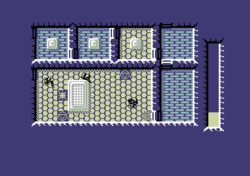Ranarama
| Ranarama | |
|---|---|
 | |
| Developer(s) | Graftgold (Steve Turner) |
| Publisher(s) | Hewson Consultants |
| Platform(s) | Amstrad CPC, Atari ST, Commodore 64, ZX Spectrum |
| Release date(s) | 1987 |
| Genre(s) | Action game, Maze game |
| Mode(s) | Single player |
Ranarama is a top-down Gauntlet-like[1] action game developed by Graftgold in 1987 and published by Hewson Consultants. It was released for the Amstrad CPC, Atari ST, Commodore 64 and ZX Spectrum[2] home computers. In 2004 it was featured as one of the games on the C64 Direct-to-TV. The title appears to be a pun on "rana", a genus of frogs.
Plot
The main character is Mervyn, a sorcerer's apprentice whose botched spell turns him into a frog just in time to save him from an invasion of evil magic-users who slay his mentors. Mervyn's arcane capabilities are intact, and the game's aim is to hunt down the attackers.[1]
Gameplay
Mervyn has four types of magic and eight increasingly potent and power-consuming spells for each: Offensive spells serve as projectile weaponry, defensive spells reduce damage etc., effect spells activate special abilities or act as area-effect attacks, power spells fuel the other kinds. The first three are usable indefinitely, but power spells degrade with damage and with a constant drain caused by the other spells that can vary from minimal to vast depending on supply and demand. They drop to level one on expiration; expiring on that level is lethal and ends the game. Commonly found energy crystals replenish some power.
The game is set in a dungeon split into eight levels that are freely traversable (but not necessarily immediately survivable), each of which is split into a labyrinthine network of rooms and houses some benevolent glyphs, 12 hostile wizards, hordes of monsters and monster generators. Rooms aren't visible before they're entered, and their inhabitants only from within. Monsters cause damage by contact, attack en masse and fall easily, wizards are much tougher and use attack spells. The latter can be defeated by attacks, but contact with them triggers a sub-game of unscrambling the mixed up word "RANARAMA" within a strict time limit. Failure expires the current power spell, but victory destroys the wizard and scatters four runes that can be used at Glyphs of Sorcery to change spells.
Similarities to other games
The game concept is inspired by a previous game for the ZX Spectrum called Quazatron (also by Steve Turner), which was itself inspired by Paradroid, created by Turner's Graftgold colleague Andrew Braybrook.
The following describes commonalities between Ranarama and Quazatron:
| Aspect | Ranarama | Quazatron |
|---|---|---|
| Enemies | Three kinds of monsters: guardians, magical weapons and the warlocks. Only warlocks can be defeated by the sub-game. | One kind: robot. All of them can be defeated by sub-game. |
| Sub-game activation | Making contact to a warlock. | Activating GRAPPLE mode and then making contact to a robot. |
| Sub-game | Ritual magic combat: unscramble the RANARAMA letters. | Overcome the enemy droid's security circuit: turn the majority of the central bar rectangles to your colour . |
| Resources | Spells. Four types: power, offence, defence and effect. | Robot parts. Five types: drive, power, weapon, chassis and devices. |
| Resource acquisition | After winning a sub-game runes may be collected, they are needed to cast spells. Runes may be stockpiled. | After winning a sub-game robot parts from the opponent may be interfaced if they're undamaged. It is not possible to save parts for future use. |
| Lives | Once you got a power spell then you can be defeated once without dying. | Same, here you got power units. |
| Energy | To avoid running out of energy you can get it from spinning power cubes or using the power spells. | Same, here you use power units. |
| Levels | Different levels have to be cleared, you can jump freely from level to level. Once a level is cleared (by killing all the warlocks) it is shown in dark. | Same, here all the robots have to be destroyed to clear a level. |
On ZX Spectrum there were 3 games with the same game concept: Quazatron (1986), Ranarama (1987) and Magnetron (1988).